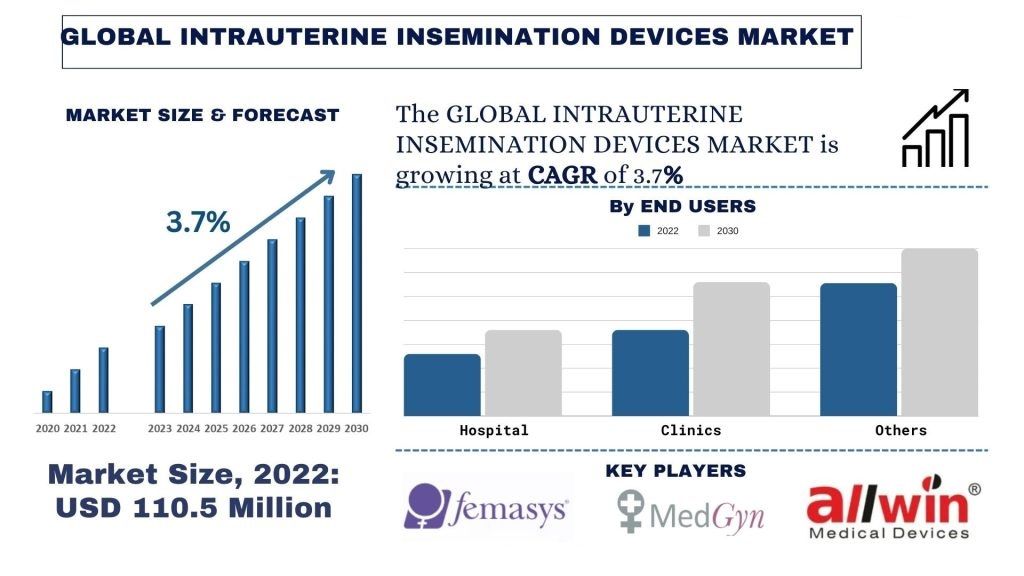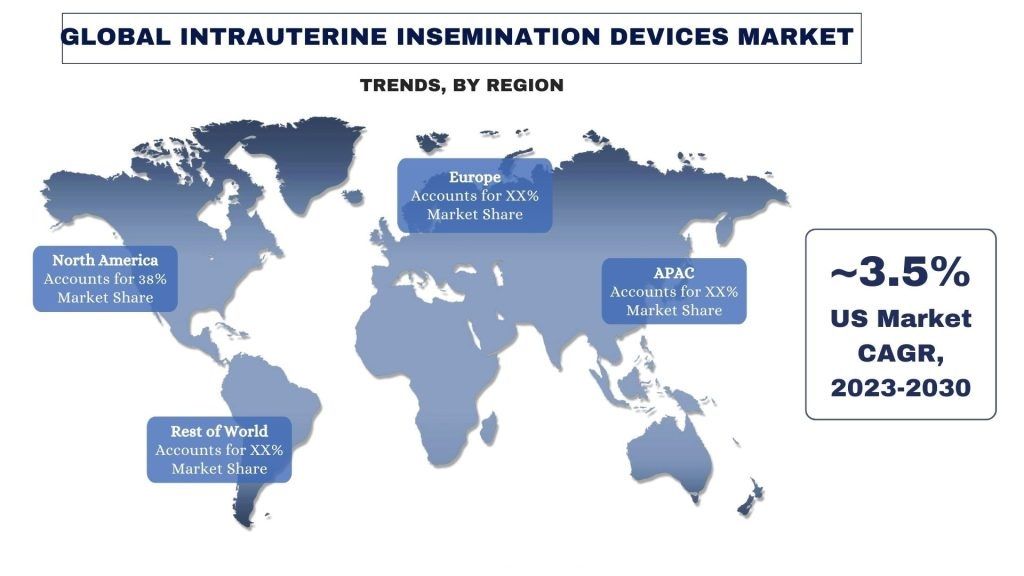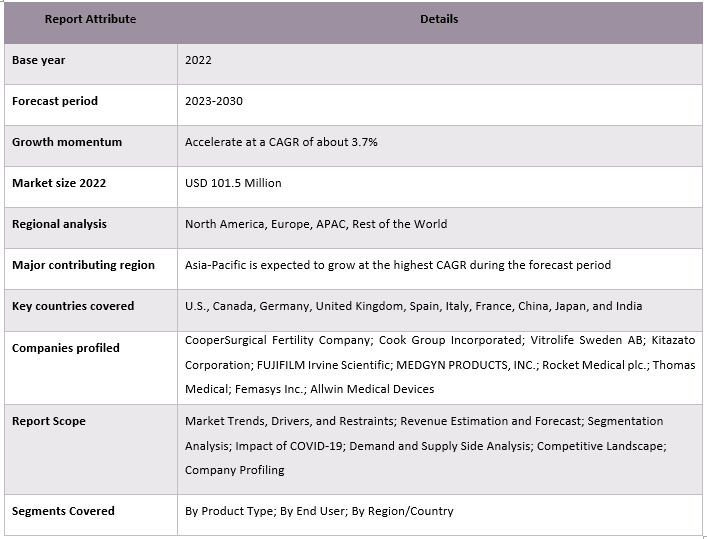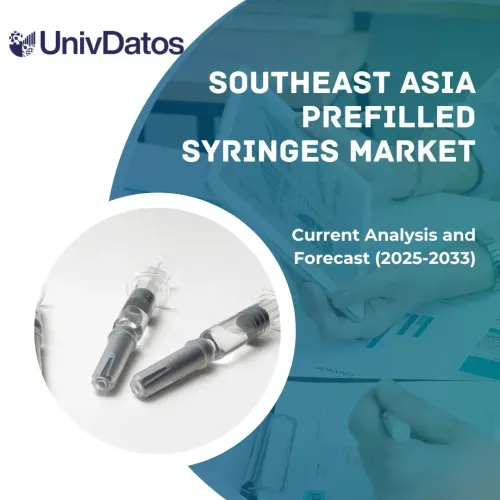- Home
- About Us
- Industry
- Services
- Reading
- Contact Us
Intrauterine Insemination Devices Market: Current Analysis and Forecast (2023-2030)
Emphasis on Product Type (Intrauterine Insemination Catheters, and Intrauterine Insemination Sperm Wash); End User (Hospitals, Clinics, Others); and Region/Country

Intrauterine Insemination Devices Market Size & Forecast
The Global Intrauterine Insemination Devices Market was valued at USD 110.5 Million approximately in 2022 and is expected to grow at a CAGR of around 3.7% during the forecast period (2023-2030).
Intrauterine Insemination Devices Market Analysis
Intrauterine insemination devices are medical devices used in the procedure of artificial insemination in case of infertility or issues in conceiving a child. Intrauterine insemination devices mainly gained prominence in the market due to the high infertility rates. For instance, according to the Cleveland Clinic, 10% of all males in the U.S. seeking to conceive are infertile. In addition to this, investments in healthcare departments as well as government awareness programs regarding infertility have increased significantly in recent years, which are the key factors that are creating opportunities for the market.
CooperSurgical Fertility Company; Cook Group Incorporated; Vitrolife Sweden AB; Kitazato Corporation; FUJIFILM Irvine Scientific; MEDGYN PRODUCTS, INC.; Rocket Medical plc.; Thomas Medical; Femasys Inc.; Allwin Medical Devices are some of the key players in the market. Several M&As along with partnerships have been undertaken by these players to facilitate customers with hi-tech and innovative products/technologies.

Intrauterine Insemination Devices Market Trends
“Amongst product type, intrauterine insemination catheters category to witness higher CAGR during the forecast period”
Based on the product type, the market is bifurcated into intrauterine insemination catheters and intrauterine insemination sperm wash. The intrauterine insemination catheters segment is expected to witness a high CAGR in the forecast period owing to the rising cases of infertility. Intrauterine insemination (IUI) catheters are slender, flexible tubes used to deliver sperm directly into the uterus during the IUI procedure. They are designed to be inserted through the cervix with minimal discomfort to the patient. The tip of the catheter is typically soft and rounded to prevent damage to the uterine lining during insertion. Additionally, some catheters may have features such as side ports or inflatable balloons to aid in the placement and retention of sperm within the uterine cavity. Thus, among the product types, intrauterine insemination catheters are expected to witness a higher CAGR during the forecast period.
“Amongst end users, hospital category held a significant share in the market in 2022”
Based on end users, the market is categorized into hospitals, clinics, and others. The hospital segment dominated the market in the year 2022 owing to the rising number of hospital admissions. This is due to higher infertility cases in hospitals as most medical devices and equipment are available in hospital settings. Apart from this, the growing number of hospital set-ups is also propelling segmental growth. For instance, according to the American Hospital Association, there were about 6,093 hospitals in the U.S. in October 2022, which comprises community hospitals run by non-profit organizations as well as by state and local governments. Thus, hospitals held a significant share of the intrauterine insemination devices market in 2022.

“Amongst regions, APAC to witness higher CAGR during the forecast period”
APAC is expected to grow with a high CAGR in the global intrauterine insemination devices market in the forecast period. Several factors such as a surge in the number of product launches, enhanced accessibility, and diversified healthcare costs are driving the market’s growth during the forecast period. For instance, in November 2020, India-based startup Subhag HealthTech launched VConceive, the world’s first home-based intrauterine insemination kit. Further, the increase in incidences of infertility is also having a positive impact on the market’s growth. There have been major awareness programs regarding infertility and product launches in the region. Thus, APAC is expected to witness a higher CAGR during the forecast period.
Intrauterine Insemination Devices Market Report Coverage

Reasons to buy this report:
- The study includes market sizing and forecasting analysis validated by authenticated key industry experts.
- The report presents a quick review of overall industry performance at one glance.
- The report covers an in-depth analysis of prominent industry peers with a primary focus on key business financials, product portfolio, expansion strategies, and recent developments.
- Detailed examination of drivers, restraints, key trends, and opportunities prevailing in the industry.
- The study comprehensively covers the market across different segments.
- Deep dive regional level analysis of the industry.
Customization Options:
The global intrauterine insemination devices market can further be customized as per the requirement or any other market segment. Besides this, UMI understands that you may have your own business needs, hence feel free to connect with us to get a report that completely suits your requirements.
Table of Content
Research Methodology for the Intrauterine Insemination Devices Market Analysis (2023-2030)
Analyzing the historical market, estimating the current market, and forecasting the future market of the global intrauterine insemination devices market were the three major steps undertaken to create and analyze the adoption of intrauterine insemination devices in major regions globally. Exhaustive secondary research was conducted to collect the historical market numbers and estimate the current market size. Secondly, to validate these insights, numerous findings and assumptions were considered. Moreover, exhaustive primary interviews were also conducted, with industry experts across the value chain of the global intrauterine insemination devices market. Post assumption and validation of market numbers through primary interviews, we employed a top-down/bottom-up approach to forecasting the complete market size. Thereafter, market breakdown and data triangulation methods were adopted to estimate and analyze the market size of segments and sub-segments of the industry pertains to. Detailed methodology is explained below:
Analysis of Historical Market Size
Step 1: In-Depth Study of Secondary Sources:
Detail secondary study was conducted to obtain the historical market size of the intrauterine insemination devices market through company internal sources such as annual reports & financial statements, performance presentations, press releases, etc., and external sources including journals, news & articles, government publications, competitor publications, sector reports, third-party database, and other credible publications.
Step 2: Market Segmentation:
After obtaining the historical market size of the intrauterine insemination devices market, we conducted a detailed secondary analysis to gather historical market insights and share for different segments & sub-segments for major regions. Major segments are included in the report as product type, end user, and regions. Further country-level analyses were conducted to evaluate the overall adoption of testing models in that region.
Step 3: Factor Analysis:
After acquiring the historical market size of different segments and sub-segments, we conducted a detailed factor analysis to estimate the current market size of the intrauterine insemination devices market. Further, we conducted factor analysis using dependent and independent variables such as product type, end user, and regions of intrauterine insemination devices. A thorough analysis was conducted for demand and supply-side scenarios considering top partnerships, mergers and acquisitions, business expansion, and product launches in the intrauterine insemination devices market sector across the globe.
Current Market Size Estimate & Forecast
Current Market Sizing: Based on actionable insights from the above 3 steps, we arrived at the current market size, key players in the global intrauterine insemination devices market, and market shares of the segments. All the required percentage shares split and market breakdowns were determined using the above-mentioned secondary approach and were verified through primary interviews.
Estimation & Forecasting: For market estimation and forecast, weights were assigned to different factors including drivers & trends, restraints, and opportunities available for the stakeholders. After analyzing these factors, relevant forecasting techniques i.e., the top-down/bottom-up approach were applied to arrive at the market forecast for 2030 for different segments and sub-segments across the major markets globally. The research methodology adopted to estimate the market size encompasses:
- The industry’s market size, in terms of revenue (USD) and the adoption rate of the intrauterine insemination devices market across the major markets domestically
- All percentage shares, splits, and breakdowns of market segments and sub-segments
- Key players in the global intrauterine insemination devices market in terms of products offered. Also, the growth strategies adopted by these players to compete in the fast-growing market
Market Size and Share Validation
Primary Research: In-depth interviews were conducted with the Key Opinion Leaders (KOLs) including Top Level Executives (CXO/VPs, Sales Head, Marketing Head, Operational Head, Regional Head, Country Head, etc.) across major regions. Primary research findings were then summarized, and statistical analysis was performed to prove the stated hypothesis. Inputs from primary research were consolidated with secondary findings, hence turning information into actionable insights.
Split of Primary Participants in Different Regions

Market Engineering
The data triangulation technique was employed to complete the overall market estimation and to arrive at precise statistical numbers for each segment and sub-segment of the global intrauterine insemination devices market. Data was split into several segments & sub-segments after studying various parameters and trends in the areas of product type, end user, and regions in the global intrauterine insemination devices market.
The main objective of the Global Proteasome Inhibitor Market Study
The current & future market trends of the global intrauterine insemination devices market were pinpointed in the study. Investors can gain strategic insights to base their discretion for investments on the qualitative and quantitative analysis performed in the study. Current and future market trends determined the overall attractiveness of the market at a regional level, providing a platform for the industrial participant to exploit the untapped market to benefit from a first-mover advantage. Other quantitative goals of the studies include:
- Analyze the current and forecast market size of the intrauterine insemination devices market in terms of value (USD). Also, analyze the current and forecast market size of different segments and sub-segments.
- Segments in the study include areas of product type, end user, and regions.
- Define and analyze the regulatory framework for the intrauterine insemination devices industry.
- Analyze the value chain involved with the presence of various intermediaries, along with analyzing customer and competitor behaviors of the industry.
- Analyze the current and forecast market size of the intrauterine insemination devices market for the major region.
- Major countries of regions studied in the report include Asia Pacific, Europe, North America, and the Rest of the World.
- Company profiles of the intrauterine insemination devices market and the growth strategies adopted by the market players to sustain in the fast-growing market.
- Deep dive regional level analysis of the industry.
Frequently Asked Questions FAQs
Q1: What is the current market size and growth potential of the intrauterine insemination devices market?
Q2: What are the driving factors for the growth of the intrauterine insemination devices market?
Q3: Which segment has the largest share of the intrauterine insemination devices market by product type?
Q4: What are the emerging technologies and trends in the intrauterine insemination devices market?
Q5: Which region will dominate the intrauterine insemination devices market?
Q6: Who are the key players operating in the intrauterine insemination devices market?
Related Reports
Customers who bought this item also bought










